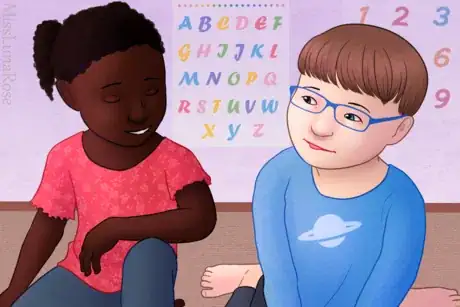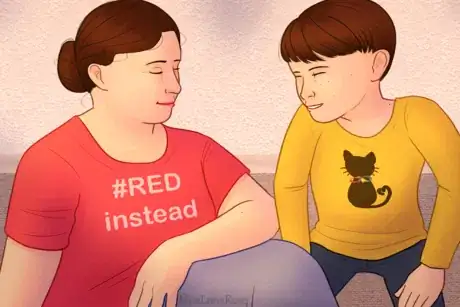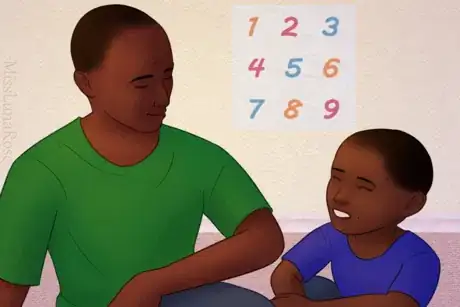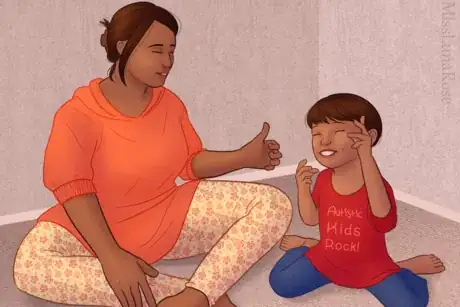This article was written by Luna Rose. Luna Rose is an autistic community member who specializes in writing and autism. She holds a degree in Informatics and has spoken at college events to improve understanding about disabilities. Luna Rose leads wikiHow's Autism Project.
There are 9 references cited in this article, which can be found at the bottom of the page.
This article has been viewed 62,456 times.
Determining why a child acts unusually can be a difficult process. Reactive Attachment Disorder (RAD) and autism can look similar on the surface, but they work very differently and involve different therapies. Here is how to start distinguishing between the two.
This article focuses on children because RAD is a childhood disorder. It is important to note that while RAD is focused in childhood, autism is lifelong and occurs in adults as well as children.
Steps
Understanding the Similarities and Differences
-
1Note the similarities between Reactive Attachment Disorder (RAD) and autism. Children with either diagnosis may experience:[1] [2]
- Difficulty with social skills (including use of language)
- Struggles with emotional regulation
- Stimming
- Need for routine
- Unusual eye contact
- May seem calmer when alone
- Avoiding affection
- Listless or sad appearance
- Self-esteem issues (not inherent to autism, but autistic children are often treated as though they are worthless)
-
2Look for the presence of traumatic events or dysfunctional relationships in the family. RAD is caused by childhood distress, such as separation from parents or changing caregivers. While autistic people can experience trauma, autism itself is not caused by trauma.Advertisement
-
3Consider the child's relationship with their primary caregiver(s). Children with RAD always have dysfunctional relationships, and autistic children may or may not be distant.
- Affection: Children with RAD avoid or indiscriminately seek affection for emotional reasons.[3] Some autistic children are uncomfortable with the physical/sensory aspects, i.e., it overwhelms them. An autistic child may be comfortable with sensory-friendly affection (e.g. hugs instead of wet kisses), and some autistic children have no problems with affection.
- Trust: Children with RAD do not value or trust their caregivers due to bad experiences.[4] Autistic children love their caregivers and are predisposed to trust them, even if they show it differently. (However, autistic children are more likely to experience abuse, which may cause trust issues.)
- In both cases, therapy and positive interaction can improve relationships with caregivers.
-
4Consider why the child has problems with eating, if there are any. Both autistic children and children with RAD may experience difficulties with food. The difference is in why: autistic children may have trouble with the food itself, while children with RAD have trouble with the social relationships involved in eating.[5]
- Autistic children may avoid certain foods due to texture or taste. How the food is organized (for example, if the chicken is touching the salad dressing) and how it fits into the daily routine may also be a factor.
- Children with RAD care more about who is offering the food, and may act differently based on who is feeding them. They may throw or give away food, or hide food and wrappers.
-
5Consider repetitive language. Repetitive language is common with both disabilities, and sounds slightly different. Autistic children may use repetition for reassurance, enjoyment, or scripting, while children with RAD mostly use it for reassurance.[6]
- Autistic children may use echolalia, and repeat words or phrases because they like the sound. They may ask repetitive questions.
- Children with RAD create scripts to deal with stressful situations, such as saying the same words whenever a loved one leaves. Their repetition sounds similar to what a younger child would do.
-
6Consider how they treat their favorite things. Autistic children tend to be more careful with treasured items in general, while children with RAD are more likely to lose or break them.[7]
- Autistic children may collect items that they like, and refuse to throw or give them away.
- An autistic child usually knows exactly where their favorite thing is, and can tell if someone moves it. A child with RAD may lose things easily.
- Children with RAD may break things accidentally, or on purpose if they are upset.
- Autistic children usually prefer familiar things, while children with RAD are more open to new ones.
-
7Watch how they play games with other children. Autistic children are usually more concerned with the rules of the game, and if it is fair. Children with RAD are more concerned about winning.[8]
- Autistic children are likely to study, talk about, and enforce rules. They may think it is unfair if they start out as winning but eventually lose.
- Children with RAD may try to bend the rules in their favor. If they lose, they may blame other people or the equipment, due to their fragile self-esteem.
- Autistic children usually prefer parallel or solitary play. Children with RAD want to play with others, so their peers can see them win.
- Autistic children prefer mechanical toys (such as trains or Legos) and toys they can examine and organize.
-
8Watch how the child plays with toys. Autistic children are usually more solitary, and organize their toys rather than creating storylines. Children with RAD will seek out others and play out a story. They may not play alone for very long.[9]
- Autistic children tend towards solitary play, treating toys as objects instead of characters, and playing with ordinary objects like sticks. They tend to organize their toys (such as lining them up by size or building the infrastructure of a doll society). They can play alone for long periods of time.
- Children with RAD seek play with others more. They might not be able to play alone for long due to poor concentration. Their stories may include difficulties from their own experiences.
-
9Consider if the child role-plays. Autistic children tend to struggle with taking on various roles. Some cannot, and others can take a reactive role if a loved one initiates the storyline. Children with RAD often prefer a certain type of role (e.g. playing the baby), often repetitively play out their past experiences with their preferred endings, and have trouble ending the role-play.[10]
-
10Look at the child's understanding of ethics. Autistic children often tend to be very concerned with right and wrong. Children with RAD typically have less understanding of moral behavior.
- Children with RAD may not have much of a conscience.[11] Autistic children may have an over-active conscience, particularly with regards to rule-following.
- When corrected, an autistic child will strive to behave the "correct" way in the future. A child with RAD may not.
-
11Consider how the child distinguishes between fact and fiction. Autistic children tend to be unsophisticated and literal in this area. Children with RAD often harbor exaggerated ideas.[12]
- Autistic children might not realize that fiction and role-play are not real. They tend to be easily fooled.
- Children with RAD tend to see themselves as either incredibly powerful or powerless. They may tell exaggerated stories about defeating or escaping powerful enemies.
- Children with RAD tend to react strongly to any threat, even if it is minor or unrealistic.
-
12Consider lying and manipulation. Children with RAD can be very skilled at these, telling elaborate lies to impress people or harm someone's reputation. Autistic children tend to be very bad at lying or deceiving others.[13]
-
13Look at the child's understanding of others' perspectives. Autistic children may be oblivious towards others' thoughts and feelings, where as children with RAD focus on others' reactions to them.[14]
- Handling emotions: Children with RAD want to evoke strong emotions in their audience. Autistic children are not interested in this, and may find strong emotions stressful or confusing.
- Handling perspectives: Children with RAD may be manipulative[15] or overly compliant, and exaggerate things to change people's opinions of them. Autistic children do not understand others' views very well.
- Handling roles: Children with RAD try to constantly take the same role (e.g. playing the victim or bully). Autistic children struggle to understand their role at all.
- Sharing: Children with RAD are anxious about sharing their own things, and may take things from others without realizing that this upsets them. Autistic children may not understand the need to share or take turns, or they may do so because it's the rules.
-
14Consider how much the child pays attention to the other person's emotions and thoughts. Autistic children tend not to understand, while children with RAD tend to be hypervigilant and overly reactive.
- Autistic children may not understand what the other person needs, what their gestures mean, or what they already know. The conversation may be stilted or unusual. They may need to be told explicitly how someone feels.
- Children with RAD can understand others better.
-
15Look at other conversation skills. Autistic children and children with RAD are both unusual in conversation skills, usually in different ways.
- Eye contact: Autistic children often offer little to no eye contact, or will stare. Children with RAD give varying eye contact based on their emotions.
- Physical closeness: Autistic children do not know how close to stand to someone, and their physical distance does not mean anything. Children with RAD use physical distance as a tool to express emotions.
- Vocabulary: Autistic children tend to have word-finding problems, and may have a strong vocabulary. Children with RAD tend to have a poor vocabulary. Children with RAD use more emotional language than autistic children do.
- Factual commentary: Autistic children recite factual information, often offering too much, because they do not know how much to say. Children with RAD do much less of this.
- Figurative language: Autistic children may be confused by idioms and sarcasm. Children with RAD often cannot handle gentle teasing, because their self-esteem is too fragile.
-
16Look at their emotional self-control. Children with both disabilities have trouble regulating their own emotions, and experience very strong feelings.[16]
- Learning skills: Autistic children tend to learn coping tips better if they get an explanation of how to do it. Children with RAD learn better from modeling.
- Confusion: Autistic children tend to have trouble understanding their and others' emotions (alexithymia).
- Outbursts: Autistic meltdowns tend to have clearer causes, and are shorter than tantrums in children with RAD.
- Panic: Autistic children are more likely to panic over unexpected things such as changes in routine, whereas children with RAD are more likely to panic over worries about having needs met (physical or emotional).
-
17Consider their memory and sense of time. Both autism and RAD involve executive dysfunction, and the child may have difficulties with their memory and sense of time.[17]
- Autistic children often have poor working memory, and excellent long-term memory. Children with RAD tend to fixate on certain events, and have selective memory. They may be confused about what they remember.
- Autistic children have trouble keeping track of time, needing clocks and disliking waiting because of the uncertainty it brings. Children with RAD are emotionally concerned; waiting may make them feel rejected or neglected.
-
18Recognize differences in duration. With proper treatment and love, RAD can be cured. While autistic people can get support and learn skills, autism itself is lifelong.
Moving Forward
-
1Research both conditions. Read a variety of essays, from medical professionals to people who live(d) with the disabilities, to people who know people with the disabilities. It helps to get both clinical and personal perspectives on what each condition can be like.
- Many autistic adults write things online that can help you understand what life is like for autistics. Since RAD can be cured, you won't find as much from people who live with it.
-
2Consider other conditions that your child may have. It's possible that they have neither RAD nor autism, and have something else instead. Or your child could have other health conditions in addition to an RAD or autism diagnosis.[18]
- Depression
- Post-Traumatic Stress Disorder (PTSD)
- Intellectual disability
- Adjustment disorders
-
3Take your child to an expert. Your doctor may know enough about the differences to make a diagnosis, or you may be referred to a specialist who better understands the differences.
- Show the specialist this wikiHow article if you'd like, or describe the symptoms.
- Avoid jumping to conclusions early on. RAD and autism can easily be mistaken for each other, or for something different. Keep an open mind.
- Speak up if you have concerns about misdiagnosis. A good doctor is a good listener.
-
4Look into therapies for your child. Whether your child has RAD or is autistic, there are many options to help them adjust and improve their quality of life. Don't hesitate to ask your doctor about the best options for your child.
- Children with RAD often benefit from individual and/or family counseling.[19]
- Autistic children benefit from therapy tailored to individual needs. Occupational therapy, AAC, speech therapy, RDI, Floortime, and other therapies may be a good idea based on the individual child.
- Avoid coercive, controlling, or experimental therapy techniques. It is best to avoid unorthodox or fringe therapies for autism or reactive attachment, as they could be harmful or even deadly.[20] Many scammers target families of autistic children in particular.[21]
References
- ↑ http://www.aettraininghubs.org.uk/wp-content/uploads/2012/05/5.4-Moran-paper-attachment.pdf
- ↑ http://www.pineyridge.net/behavioral-disorders/reactive-attachment/causes-effects-symptoms
- ↑ https://childdevelopmentinfo.com/child-psychology/reactive-attachment-disorder/#.WM_zY_nyu00
- ↑ https://childdevelopmentinfo.com/child-psychology/reactive-attachment-disorder/#.WM_zY_nyu00
- ↑ http://www.aettraininghubs.org.uk/wp-content/uploads/2012/05/5.4-Moran-paper-attachment.pdf
- ↑ http://www.aettraininghubs.org.uk/wp-content/uploads/2012/05/5.4-Moran-paper-attachment.pdf
- ↑ http://www.aettraininghubs.org.uk/wp-content/uploads/2012/05/5.4-Moran-paper-attachment.pdf
- ↑ http://www.aettraininghubs.org.uk/wp-content/uploads/2012/05/5.4-Moran-paper-attachment.pdf
- ↑ http://www.aettraininghubs.org.uk/wp-content/uploads/2012/05/5.4-Moran-paper-attachment.pdf
- ↑ http://www.aettraininghubs.org.uk/wp-content/uploads/2012/05/5.4-Moran-paper-attachment.pdf
- ↑ http://www.pineyridge.net/behavioral-disorders/reactive-attachment/causes-effects-symptoms
- ↑ http://www.aettraininghubs.org.uk/wp-content/uploads/2012/05/5.4-Moran-paper-attachment.pdf
- ↑ http://www.aettraininghubs.org.uk/wp-content/uploads/2012/05/5.4-Moran-paper-attachment.pdf
- ↑ http://www.aettraininghubs.org.uk/wp-content/uploads/2012/05/5.4-Moran-paper-attachment.pdf
- ↑ http://blog.asha.org/2013/07/11/kid-confidential-what-reactive-attachment-disorder-looks-like/
- ↑ http://www.aettraininghubs.org.uk/wp-content/uploads/2012/05/5.4-Moran-paper-attachment.pdf
- ↑ http://www.aettraininghubs.org.uk/wp-content/uploads/2012/05/5.4-Moran-paper-attachment.pdf
- ↑ http://www.mayoclinic.org/diseases-conditions/reactive-attachment-disorder/basics/tests-diagnosis/con-20032126
- ↑ http://www.mayoclinic.org/diseases-conditions/reactive-attachment-disorder/basics/treatment/con-20032126
- ↑ http://www.mayoclinic.org/diseases-conditions/reactive-attachment-disorder/basics/treatment/con-20032126
- ↑ https://www.theatlantic.com/health/archive/2016/09/fringe-therapies-spectrum/501023/
- ↑ https://imfar.confex.com/imfar/2011/webprogram/Paper9121.html
- Much of this is adapted from the Coventry Grid, which details differences between autism and RAD.

















































































Medical Disclaimer
The content of this article is not intended to be a substitute for professional medical advice, examination, diagnosis, or treatment. You should always contact your doctor or other qualified healthcare professional before starting, changing, or stopping any kind of health treatment.
Read More...